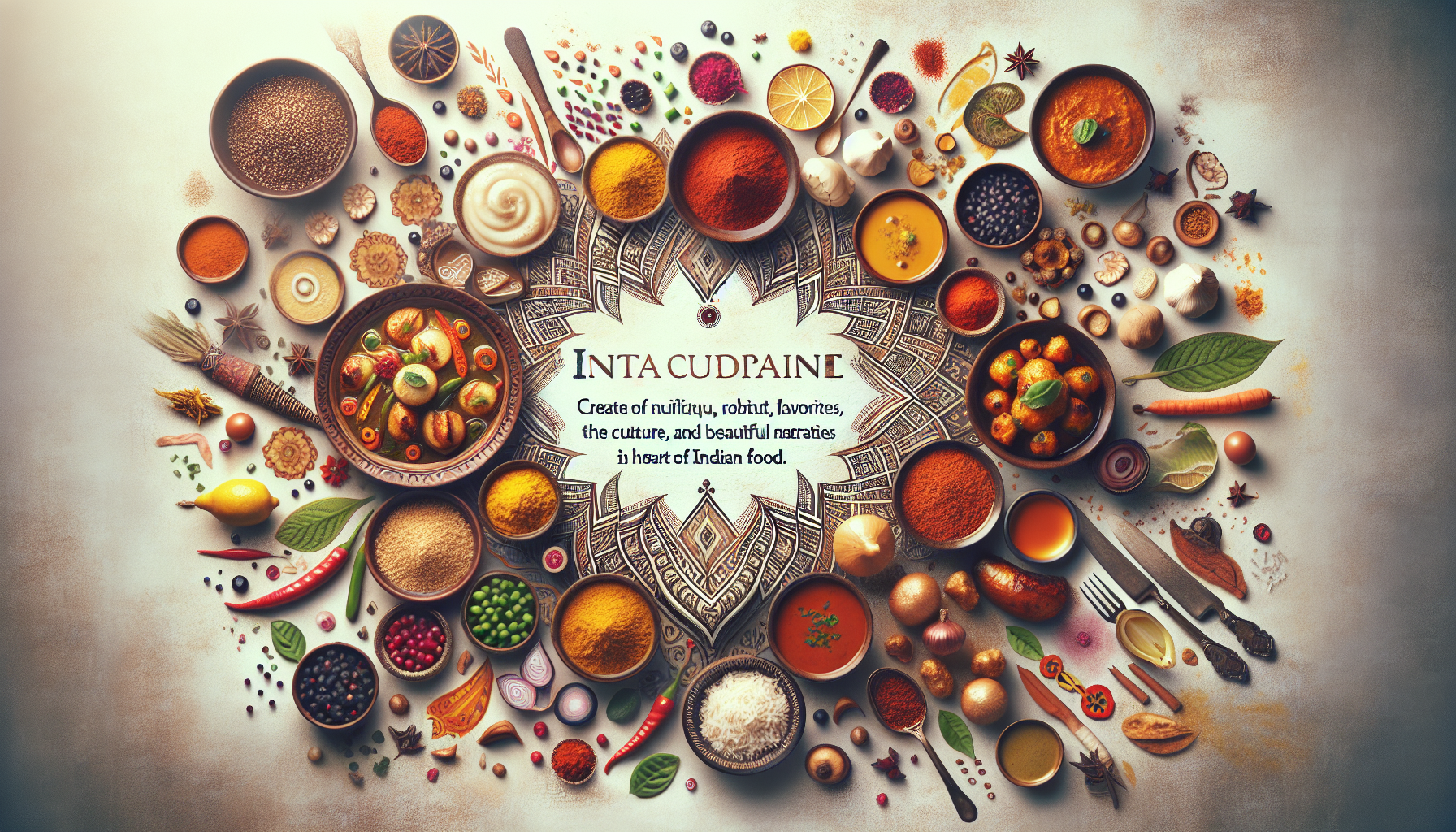Immerse yourself in the vibrant and mouthwatering world of Indian cuisine through the captivating lens of food documentaries. Discover the rich and diverse flavors that define Indian culture as you embark on a visual feast like no other. Journey through the aromatic spices and regional specialties that make Indian cuisine so unique and delve into the captivating stories behind each dish. Whether you’re an avid food enthusiast or simply looking to broaden your culinary horizons, these Indian food documentaries are sure to leave you hungry for more. Explore the influence of Indian food documentaries and prepare to tantalize your taste buds with the flavors of India.

Overview of Indian Food Documentaries
Introduction to Indian food documentaries
Indian food documentaries are a fascinating and captivating way to explore the rich and diverse culinary traditions of India. These documentaries provide a unique opportunity to immerse yourself in the sights, sounds, and stories behind some of the most beloved dishes and cooking techniques. Whether you are a food enthusiast or simply curious about Indian cuisine, these documentaries offer a visual feast that not only educates but also celebrates the cultural significance of food in India.
Popular Indian food documentaries
There are several Indian food documentaries that have captured the attention of a global audience. These documentaries showcase the beauty and complexity of Indian cuisine, as well as the stories of the people behind the dishes. “The Great Indian Rasoi” takes viewers on a journey across India to discover the traditional recipes and cooking methods passed down through generations. “Chef’s Table: Gaggan Anand” focuses on the innovative and boundary-pushing cooking of the renowned Indian chef Gaggan Anand. “Street Food: India” explores the vibrant street food culture in various cities of India, highlighting the diverse flavors and culinary traditions found in each region.
Impact of Indian food documentaries on global audience
Indian food documentaries have had a significant impact on the global audience, opening their eyes to the diverse and vibrant culinary world of India. Through these documentaries, viewers are able to gain a deeper appreciation for the cultural significance behind each dish and understand the techniques and traditions that go into creating them. This exposure has not only led to an increased interest in Indian cuisine but has also fostered a greater understanding and respect for the rich cultural heritage of India. As a result, more people are venturing beyond their comfort zones and exploring Indian restaurants, trying new flavors, and incorporating Indian spices and ingredients into their own cooking. The influence of these documentaries has extended beyond the culinary world, attracting tourists to India in search of authentic food experiences and inspiring chefs from other countries to experiment with Indian flavors in their own creations. Overall, Indian food documentaries have played a crucial role in promoting cultural exchange and appreciation on a global scale.
Cultural Significance of Indian Food
Indian cuisine as a representation of culture
Indian cuisine is not just about food; it is a representation of the diverse culture, traditions, and history of India. Each dish tells a story, encapsulating centuries of culinary evolution and regional influences. The use of various spices, flavors, and cooking techniques varies from region to region, reflecting the unique cultural heritage of that particular area. Whether it is the rich and creamy curries of North India or the tangy and spicy flavors of South India, every plate of Indian food is a celebration of the cultural diversity and heritage that defines India.
Traditional cooking methods and rituals
Indian cooking is deeply rooted in tradition and often involves elaborate rituals and techniques that have been passed down through generations. From the slow and labor-intensive process of hand-grinding spices to the art of tempering, every step in the cooking process is carried out with utmost care and attention. Many traditional Indian recipes require hours of slow cooking, allowing the flavors to develop and meld together, resulting in dishes that are bursting with depth and complexity.
Importance of spices in Indian cuisine
Spices are an integral part of Indian cuisine and play a pivotal role in enhancing the flavor and aroma of dishes. From the vibrant red of Kashmiri chili to the earthy warmth of cumin, each spice adds its unique character to a dish. The artful combination and balance of spices are what sets Indian cuisine apart and makes it so distinctive. Spices are not only used for flavor but also for their medicinal properties, with many traditional spice blends having health benefits.

Exploring Regional Indian Cuisines
North Indian cuisine
North Indian cuisine is renowned for its rich flavors and indulgent dishes. Influenced by Mughlai and Persian cooking techniques, North Indian cuisine often incorporates lavish ingredients like ghee, cream, and dry fruits. Popular dishes include biryani, butter chicken, and naan bread. The use of spices like cardamom, cinnamon, and cloves adds a warmth and complexity to the dishes.
South Indian cuisine
South Indian cuisine is characterized by its extensive use of rice, lentils, and coconut. The flavors are often tangy and spicy, with the use of tamarind and chili. Staples like dosa, idli, and sambar are famous not only in India but also around the world. Coconut-based curries and the unique combination of flavors make South Indian cuisine a favorite among food enthusiasts.
East Indian cuisine
East Indian cuisine is a delightful blend of flavors influenced by Bengali, Odia, and Assamese cooking traditions. Rice, fish, and various seafood preparations form the backbone of this cuisine. The use of mustard seeds, poppy seeds, and panch phoron (a five-spice blend) gives a distinct aroma and taste to East Indian dishes. Famous dishes include macher jhol (fish curry), mishti doi (sweet yogurt), and sandesh (milk-based sweet).
West Indian cuisine
West Indian cuisine is known for its vibrant and spicy flavors. Influenced by Gujarati and Maharashtrian cooking, this cuisine offers a wide range of vegetarian and non-vegetarian delicacies. The use of peanuts, coconut, and tamarind gives a unique character to dishes. Popular dishes from this region include dhokla, vada pav, and pav bhaji.
Diverse Flavors and Ingredients
Vegetarian and vegan options in Indian cuisine
Indian cuisine offers a vast array of vegetarian and vegan options, making it a haven for those following plant-based diets. Dishes like dal (lentil curry), chana masala (spiced chickpeas), and baingan bharta (roasted eggplant) showcase the versatility and deliciousness of vegetarian food. Vegan dishes also abound, with options like aloo gobi (potato and cauliflower curry) and vegan mango lassi.
Traditional sweets and desserts
Indian sweets, or mithai, are a beloved part of the cuisine and hold a special place in celebrations and festivals. From the syrupy and aromatic gulab jamun to the rich and creamy kheer, these sweets are cherished by people of all ages. Each region in India has its own unique sweet offerings, such as the popular rasgulla from West Bengal or the mouth-watering jalebi from Rajasthan.
Importance of rice and wheat
Rice and wheat are staple grains in Indian cuisine and form the foundation of many dishes. Rice is widely consumed in South India, where it is often eaten with various curries and chutneys. Wheat is predominantly used in North India, where it is used to make chapatis (flatbreads) and other bread-based dishes. Both rice and wheat provide essential carbohydrates and are integral to the Indian diet.
Use of lentils and legumes
Lentils, also known as dal, are a key source of protein in Indian cuisine. They are used in a myriad of dishes, ranging from soups and stews to curries and side dishes. Lentils are not only nutritious but also economical, making them a popular choice among Indian households. Legumes such as chickpeas and kidney beans are also commonly used to add texture and flavor to dishes.
Incorporation of seafood and meats
While India is known for its vegetarian cuisine, seafood and meats also hold a significant place in certain regions and communities. Coastal regions like Kerala and Goa are famous for their seafood delicacies, with dishes like prawn curry and fish fry being enjoyed by locals and tourists alike. In the northern states, meat-based dishes like tandoori chicken and lamb curry are popular and reflect the culinary influences of Mughlai cuisine.

Influence on Global Food Trends
Integration of Indian flavors in international cuisine
Indian flavors and spices have become increasingly popular and are now being integrated into international cuisine. Chefs from around the world are incorporating Indian spices like turmeric, cumin, and cardamom into their recipes, adding a unique twist to familiar dishes. The use of these flavors has not only introduced new taste profiles but has also showcased the versatility and depth of Indian cuisine.
Adoption of Indian cooking techniques and tools
Indian cooking techniques, such as tandoori grilling and the use of a tawa (flat griddle), have found their way into kitchens worldwide. These techniques add a smoky and charred flavor to grilled meats and vegetables, enticing food enthusiasts to experiment with new flavors and techniques. Traditional Indian cooking vessels like the pressure cooker and clay pots are also being embraced for their ability to enhance flavors and ensure tender and flavorful results.
Growing popularity and demand for Indian spices
The growing popularity of Indian cuisine has led to an increased demand for Indian spices. Once considered exotic and hard to find, Indian spices like garam masala, curry powder, and fenugreek are now readily available in supermarkets around the world. Food enthusiasts and home cooks are eager to incorporate these aromatic and flavorful spices into their dishes, resulting in a global spice revolution.
Emergence of Indian fusion dishes
The influence of Indian cuisine has transcended cultural boundaries, giving rise to a unique fusion of flavors and culinary styles. Indian-inspired fusion dishes, such as butter chicken pizza and masala burgers, have gained popularity and become a testament to the adaptability and open-mindedness of the global culinary scene. These dishes marry the bold and vibrant flavors of Indian cuisine with familiar ingredients and techniques, creating a truly exciting gastronomic experience.
Impact on Tourism in India
Promotion of culinary tourism
Indian food documentaries have played a significant role in promoting culinary tourism in India. Through these documentaries, viewers are enticed by the diverse flavors, vibrant street food scenes, and traditional cooking methods, inspiring them to embark on food-related travel adventures. Travelers now flock to India to explore the local markets, taste authentic regional dishes, and immerse themselves in the rich culinary traditions that make Indian cuisine so unique.
Increased interest in food-related travel
The global popularity and influence of Indian food documentaries have sparked a newfound enthusiasm for food-related travel. Travelers are seeking immersive and authentic experiences where they can discover the stories behind the dishes they love. A visit to India offers a sensory journey through bustling spice markets, aromatic street food stalls, and traditional kitchens, allowing travelers to connect with the local culture through the universal language of food.
Celebrity chefs and gastronomic tours
Indian food documentaries featuring celebrity chefs have also had a significant impact on tourism. Viewers are often inspired by these charismatic chefs and their innovative approaches to Indian cuisine. This has led to the emergence of gastronomic tours that offer participants the opportunity to meet these chefs, learn their cooking techniques, and taste their creations. These tours not only showcase the culinary talent in India but also provide an intimate and memorable experience for food enthusiasts.
Revival of forgotten regional cuisines
Indian food documentaries have helped revive and popularize forgotten regional cuisines. Many traditional recipes and cooking methods were at risk of being lost with the passage of time. However, these documentaries have shed a spotlight on these lesser-known cuisines, bringing them back into the limelight and preserving their heritage. This revival has not only boosted tourism in regions known for their unique culinary traditions but has also provided economic opportunities for local communities involved in preserving these traditional practices.
Promoting Health and Wellness
Ayurvedic principles in Indian cooking
Indian cuisine is deeply rooted in ancient Ayurvedic principles, which emphasize the connection between food and health. Ayurveda focuses on using natural ingredients and spices to create balanced meals that nourish both the body and mind. These principles are evident in the harmonious blend of flavors, textures, and spices that are inherent to Indian cooking, making it a healthy and holistic culinary choice.
Medicinal properties of Indian spices and ingredients
Indian spices and ingredients are not only known for their flavor but also for their medicinal properties. Turmeric, for example, contains curcumin, a compound with anti-inflammatory and antioxidant properties. Other spices like cardamom, cinnamon, and ginger are also known for their various health benefits. Indian cuisine, with its abundance of spices and natural ingredients, offers a delicious way to incorporate these medicinal properties into one’s diet.
Rise of wellness retreats and cooking classes
The global appreciation for Indian cuisine’s health benefits has led to the rise of wellness retreats and cooking classes that focus on Ayurvedic and healthy eating. These retreats provide participants with the opportunity to learn about the nutritional value of Indian ingredients, participate in cooking workshops, and experience the benefits of a balanced and mindful diet. From yoga retreats in Goa to Ayurvedic wellness centers in Kerala, these experiences offer a holistic approach to health and wellness, grounded in the principles of Indian cooking.
Preservation of Traditional Recipes
Digitization and documentation of traditional recipes
Indian food documentaries have played a vital role in the digitization and documentation of traditional recipes. Many traditional recipes were passed down orally through families, and the risk of losing these recipes posed a threat to the preservation of culinary heritage. However, with the advent of food documentaries, these recipes have been captured on film, ensuring their survival and making them accessible to future generations.
Revitalization of ancient cooking techniques
Indian food documentaries have also shed light on ancient cooking techniques that were on the brink of extinction. Techniques like dum pukht (slow-cooking in a sealed vessel) and dhungar (smoking technique) were at risk of being forgotten. However, these documentaries have showcased the charm and value of these traditional techniques, leading to a revitalization of interest among chefs and home cooks alike.
Efforts to conserve endangered ingredients
Some Indian food documentaries have highlighted the endangered status of certain ingredients and the need for conservation. Wild edible plants, traditional rice varieties, and native spices are just a few examples of ingredients that are in danger of disappearing. By raising awareness about these issues, these documentaries have inspired individuals and organizations to take action, promoting sustainable agriculture, biodiversity, and responsible sourcing.
Challenges and Controversies
Cultural appropriation of Indian cuisine
While Indian cuisine has gained global popularity, it has also faced challenges in the form of cultural appropriation. The commercialization and adaptation of Indian dishes without proper understanding or respect for their cultural significance can be seen as disrespectful and insensitive. Authenticity and representation in Indian food have become important topics of discussion, as it is essential to recognize and appreciate the cultural context from which these dishes originate.
Authenticity and representation in documentaries
Indian food documentaries have also faced criticism and controversy regarding the authenticity and representation of Indian cuisine. Critics argue that some documentaries may focus on more well-known or popular dishes, neglecting the vast diversity of Indian regional cuisines. It is important for these documentaries to strike a balance between showcasing familiar dishes and introducing lesser-known culinary gems to provide a more comprehensive and authentic representation of Indian cuisine.
Commercialization and commodification of Indian food
The growing popularity of Indian cuisine has also led to its commercialization and commodification. Indian dishes have been adapted and modified to suit the preferences of different markets, diluting the authenticity and integrity of the original recipes. It is essential to strike a balance between making Indian cuisine accessible to a global audience while respecting its cultural significance and honoring the traditional cooking methods and flavors.
Conclusion
Indian food documentaries have had a profound and lasting impact on the global audience, fostering a deeper appreciation and celebration of Indian culinary diversity. These documentaries have not only showcased the rich and vibrant flavors of Indian cuisine but have also provided a glimpse into the cultural significance and historical roots of each dish. From promoting health and wellness to reviving forgotten regional cuisines, these documentaries have sparked a culinary revolution, leading to the integration of Indian flavors and techniques in international cuisine. As the popularity of Indian cuisine continues to grow, it is crucial to strike a balance between commercialization and cultural preservation, ensuring that the rich tapestry of Indian flavors and traditions are cherished and respected. So, whether you are a seasoned food enthusiast or someone just beginning to explore the world of Indian cuisine, these documentaries are a must-watch, offering a visual feast that will leave you hungry for more.
